Marketing Consumer Behavior
VerifiedAdded on 2023/06/14
|17
|5409
|316
AI Summary
This essay discusses the influence of individual factors on consumer behavior in the purchase of Remedy Kombucha. It covers the customer's buying process, needs, attitudes, and more. The essay also highlights the importance of considering customers' needs in the decision-making process.
Contribute Materials
Your contribution can guide someone’s learning journey. Share your
documents today.
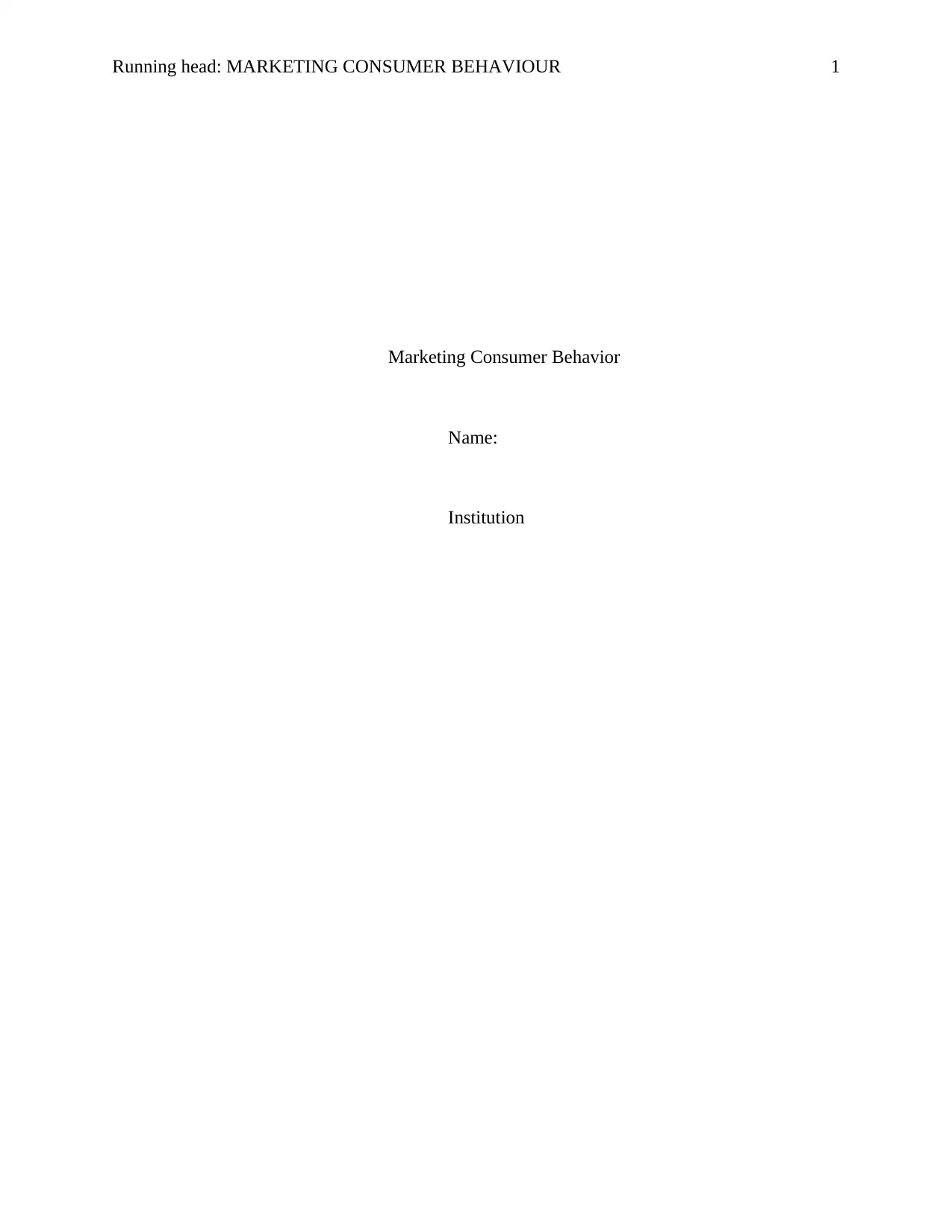
Running head: MARKETING CONSUMER BEHAVIOUR 1
Marketing Consumer Behavior
Name:
Institution
Marketing Consumer Behavior
Name:
Institution
Secure Best Marks with AI Grader
Need help grading? Try our AI Grader for instant feedback on your assignments.
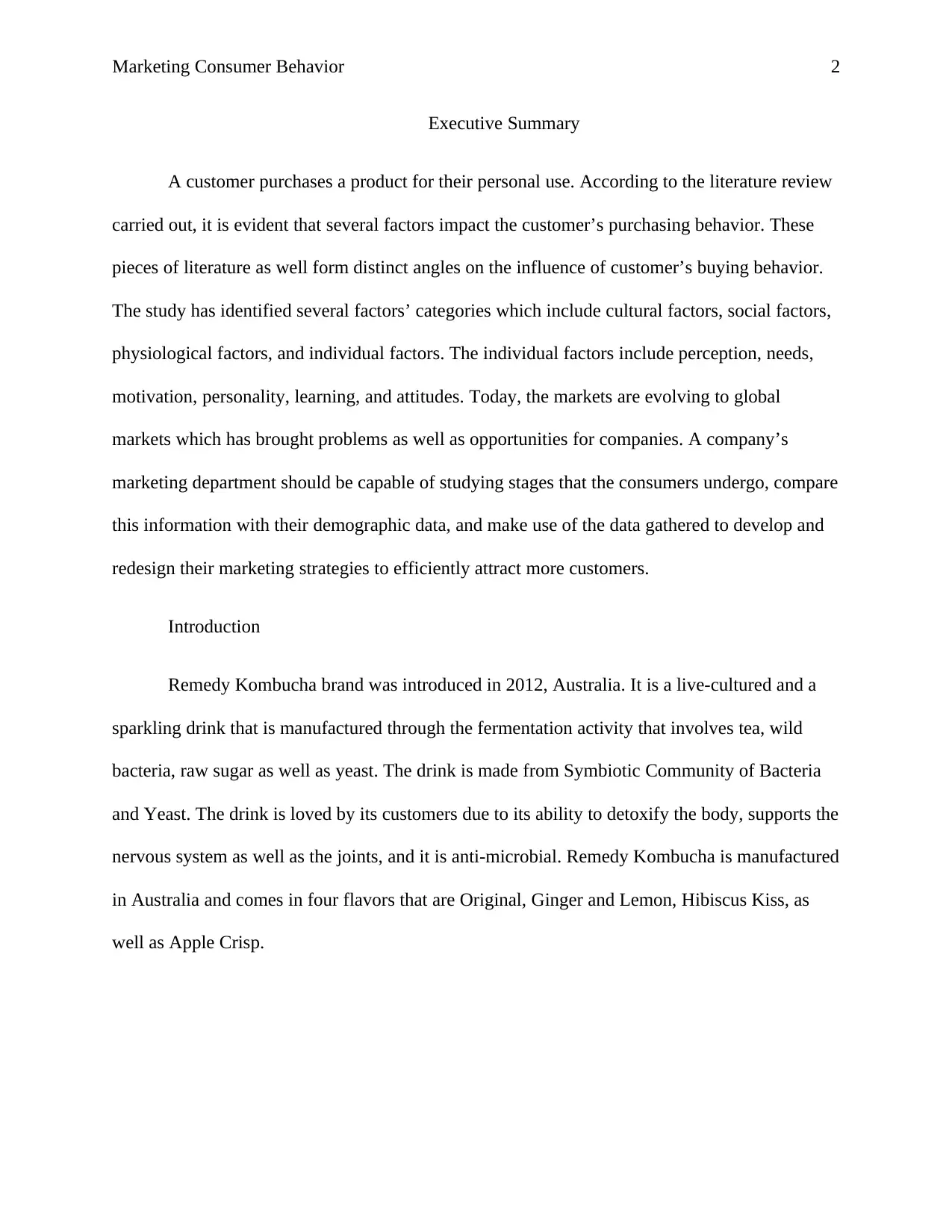
Marketing Consumer Behavior 2
Executive Summary
A customer purchases a product for their personal use. According to the literature review
carried out, it is evident that several factors impact the customer’s purchasing behavior. These
pieces of literature as well form distinct angles on the influence of customer’s buying behavior.
The study has identified several factors’ categories which include cultural factors, social factors,
physiological factors, and individual factors. The individual factors include perception, needs,
motivation, personality, learning, and attitudes. Today, the markets are evolving to global
markets which has brought problems as well as opportunities for companies. A company’s
marketing department should be capable of studying stages that the consumers undergo, compare
this information with their demographic data, and make use of the data gathered to develop and
redesign their marketing strategies to efficiently attract more customers.
Introduction
Remedy Kombucha brand was introduced in 2012, Australia. It is a live-cultured and a
sparkling drink that is manufactured through the fermentation activity that involves tea, wild
bacteria, raw sugar as well as yeast. The drink is made from Symbiotic Community of Bacteria
and Yeast. The drink is loved by its customers due to its ability to detoxify the body, supports the
nervous system as well as the joints, and it is anti-microbial. Remedy Kombucha is manufactured
in Australia and comes in four flavors that are Original, Ginger and Lemon, Hibiscus Kiss, as
well as Apple Crisp.
Executive Summary
A customer purchases a product for their personal use. According to the literature review
carried out, it is evident that several factors impact the customer’s purchasing behavior. These
pieces of literature as well form distinct angles on the influence of customer’s buying behavior.
The study has identified several factors’ categories which include cultural factors, social factors,
physiological factors, and individual factors. The individual factors include perception, needs,
motivation, personality, learning, and attitudes. Today, the markets are evolving to global
markets which has brought problems as well as opportunities for companies. A company’s
marketing department should be capable of studying stages that the consumers undergo, compare
this information with their demographic data, and make use of the data gathered to develop and
redesign their marketing strategies to efficiently attract more customers.
Introduction
Remedy Kombucha brand was introduced in 2012, Australia. It is a live-cultured and a
sparkling drink that is manufactured through the fermentation activity that involves tea, wild
bacteria, raw sugar as well as yeast. The drink is made from Symbiotic Community of Bacteria
and Yeast. The drink is loved by its customers due to its ability to detoxify the body, supports the
nervous system as well as the joints, and it is anti-microbial. Remedy Kombucha is manufactured
in Australia and comes in four flavors that are Original, Ginger and Lemon, Hibiscus Kiss, as
well as Apple Crisp.
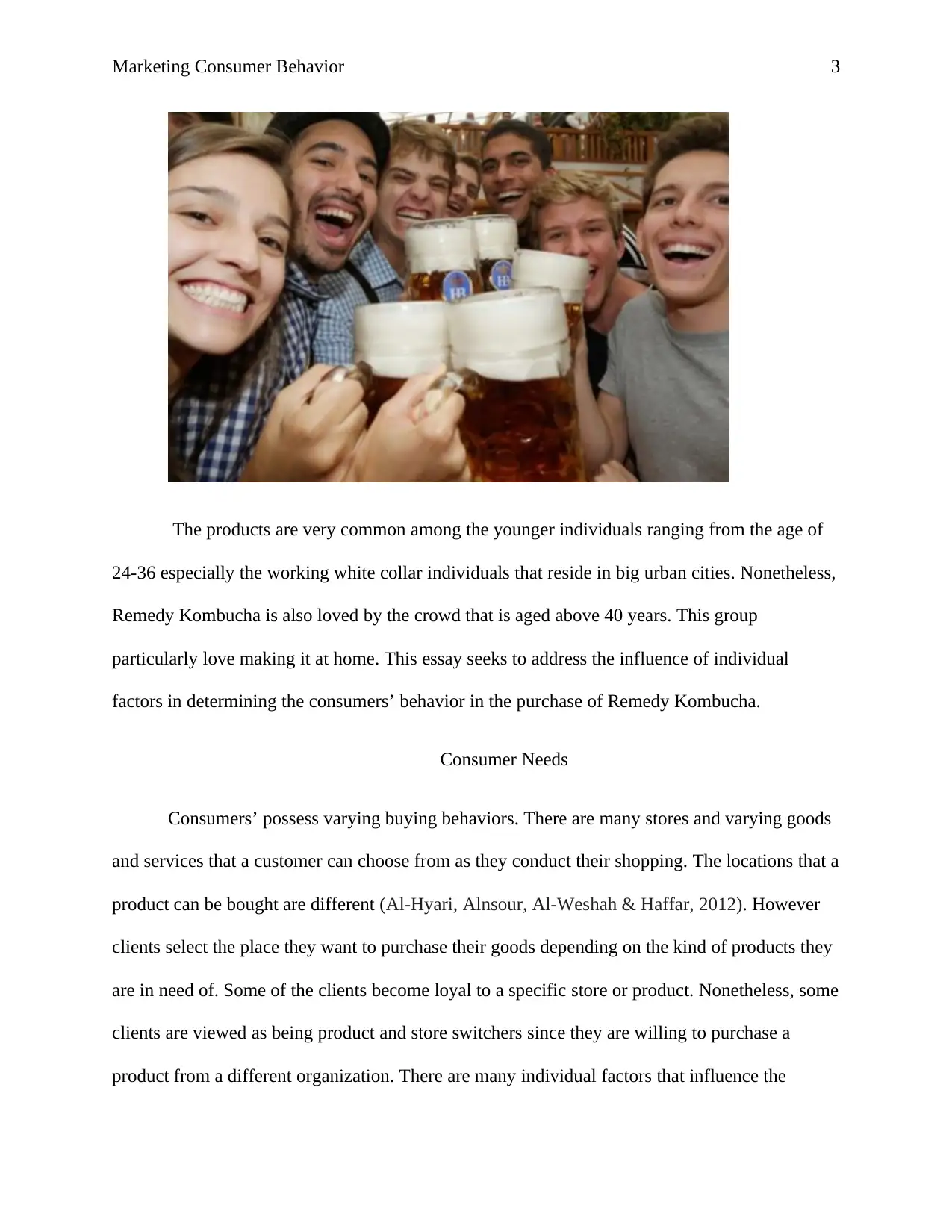
Marketing Consumer Behavior 3
The products are very common among the younger individuals ranging from the age of
24-36 especially the working white collar individuals that reside in big urban cities. Nonetheless,
Remedy Kombucha is also loved by the crowd that is aged above 40 years. This group
particularly love making it at home. This essay seeks to address the influence of individual
factors in determining the consumers’ behavior in the purchase of Remedy Kombucha.
Consumer Needs
Consumers’ possess varying buying behaviors. There are many stores and varying goods
and services that a customer can choose from as they conduct their shopping. The locations that a
product can be bought are different (Al-Hyari, Alnsour, Al-Weshah & Haffar, 2012). However
clients select the place they want to purchase their goods depending on the kind of products they
are in need of. Some of the clients become loyal to a specific store or product. Nonetheless, some
clients are viewed as being product and store switchers since they are willing to purchase a
product from a different organization. There are many individual factors that influence the
The products are very common among the younger individuals ranging from the age of
24-36 especially the working white collar individuals that reside in big urban cities. Nonetheless,
Remedy Kombucha is also loved by the crowd that is aged above 40 years. This group
particularly love making it at home. This essay seeks to address the influence of individual
factors in determining the consumers’ behavior in the purchase of Remedy Kombucha.
Consumer Needs
Consumers’ possess varying buying behaviors. There are many stores and varying goods
and services that a customer can choose from as they conduct their shopping. The locations that a
product can be bought are different (Al-Hyari, Alnsour, Al-Weshah & Haffar, 2012). However
clients select the place they want to purchase their goods depending on the kind of products they
are in need of. Some of the clients become loyal to a specific store or product. Nonetheless, some
clients are viewed as being product and store switchers since they are willing to purchase a
product from a different organization. There are many individual factors that influence the
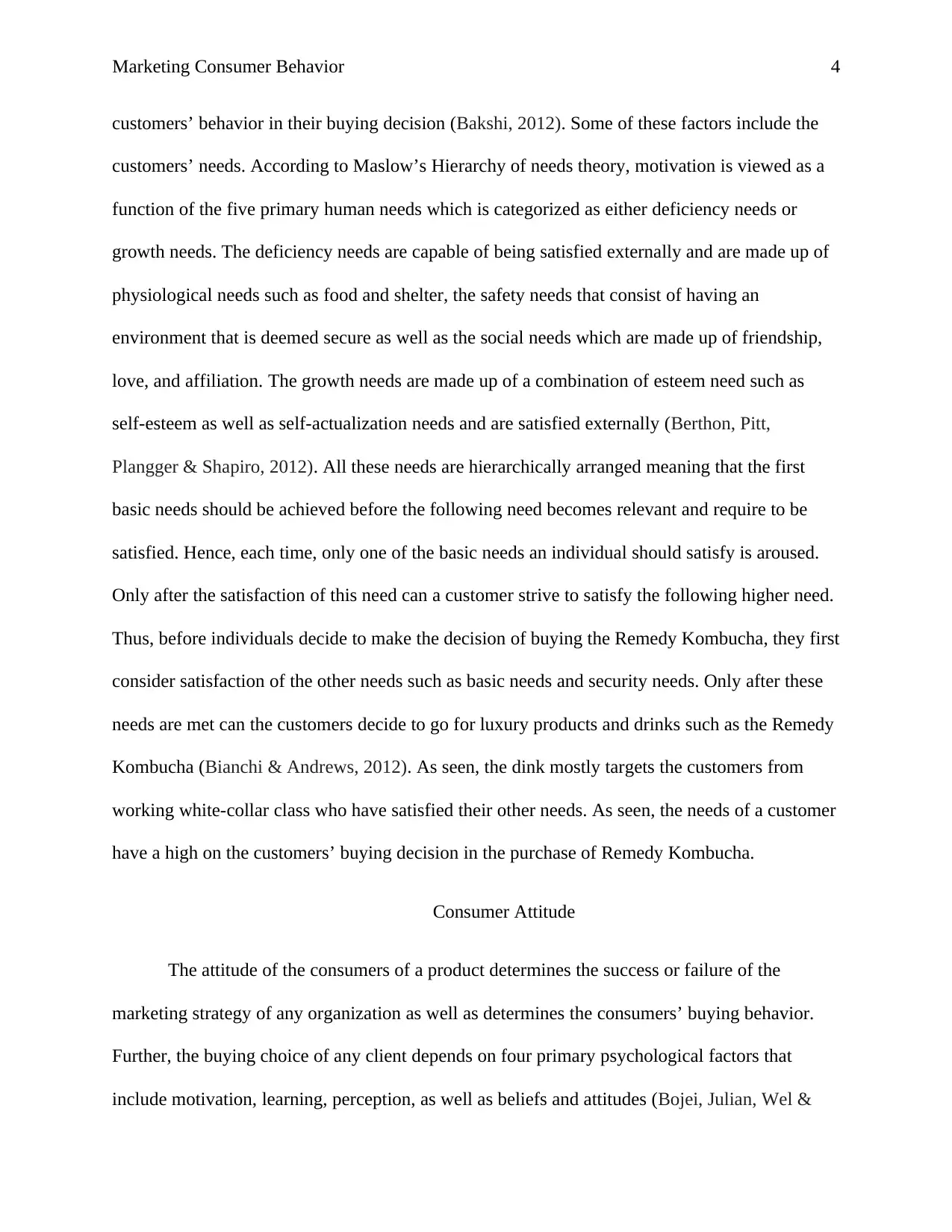
Marketing Consumer Behavior 4
customers’ behavior in their buying decision (Bakshi, 2012). Some of these factors include the
customers’ needs. According to Maslow’s Hierarchy of needs theory, motivation is viewed as a
function of the five primary human needs which is categorized as either deficiency needs or
growth needs. The deficiency needs are capable of being satisfied externally and are made up of
physiological needs such as food and shelter, the safety needs that consist of having an
environment that is deemed secure as well as the social needs which are made up of friendship,
love, and affiliation. The growth needs are made up of a combination of esteem need such as
self-esteem as well as self-actualization needs and are satisfied externally (Berthon, Pitt,
Plangger & Shapiro, 2012). All these needs are hierarchically arranged meaning that the first
basic needs should be achieved before the following need becomes relevant and require to be
satisfied. Hence, each time, only one of the basic needs an individual should satisfy is aroused.
Only after the satisfaction of this need can a customer strive to satisfy the following higher need.
Thus, before individuals decide to make the decision of buying the Remedy Kombucha, they first
consider satisfaction of the other needs such as basic needs and security needs. Only after these
needs are met can the customers decide to go for luxury products and drinks such as the Remedy
Kombucha (Bianchi & Andrews, 2012). As seen, the dink mostly targets the customers from
working white-collar class who have satisfied their other needs. As seen, the needs of a customer
have a high on the customers’ buying decision in the purchase of Remedy Kombucha.
Consumer Attitude
The attitude of the consumers of a product determines the success or failure of the
marketing strategy of any organization as well as determines the consumers’ buying behavior.
Further, the buying choice of any client depends on four primary psychological factors that
include motivation, learning, perception, as well as beliefs and attitudes (Bojei, Julian, Wel &
customers’ behavior in their buying decision (Bakshi, 2012). Some of these factors include the
customers’ needs. According to Maslow’s Hierarchy of needs theory, motivation is viewed as a
function of the five primary human needs which is categorized as either deficiency needs or
growth needs. The deficiency needs are capable of being satisfied externally and are made up of
physiological needs such as food and shelter, the safety needs that consist of having an
environment that is deemed secure as well as the social needs which are made up of friendship,
love, and affiliation. The growth needs are made up of a combination of esteem need such as
self-esteem as well as self-actualization needs and are satisfied externally (Berthon, Pitt,
Plangger & Shapiro, 2012). All these needs are hierarchically arranged meaning that the first
basic needs should be achieved before the following need becomes relevant and require to be
satisfied. Hence, each time, only one of the basic needs an individual should satisfy is aroused.
Only after the satisfaction of this need can a customer strive to satisfy the following higher need.
Thus, before individuals decide to make the decision of buying the Remedy Kombucha, they first
consider satisfaction of the other needs such as basic needs and security needs. Only after these
needs are met can the customers decide to go for luxury products and drinks such as the Remedy
Kombucha (Bianchi & Andrews, 2012). As seen, the dink mostly targets the customers from
working white-collar class who have satisfied their other needs. As seen, the needs of a customer
have a high on the customers’ buying decision in the purchase of Remedy Kombucha.
Consumer Attitude
The attitude of the consumers of a product determines the success or failure of the
marketing strategy of any organization as well as determines the consumers’ buying behavior.
Further, the buying choice of any client depends on four primary psychological factors that
include motivation, learning, perception, as well as beliefs and attitudes (Bojei, Julian, Wel &
Paraphrase This Document
Need a fresh take? Get an instant paraphrase of this document with our AI Paraphraser
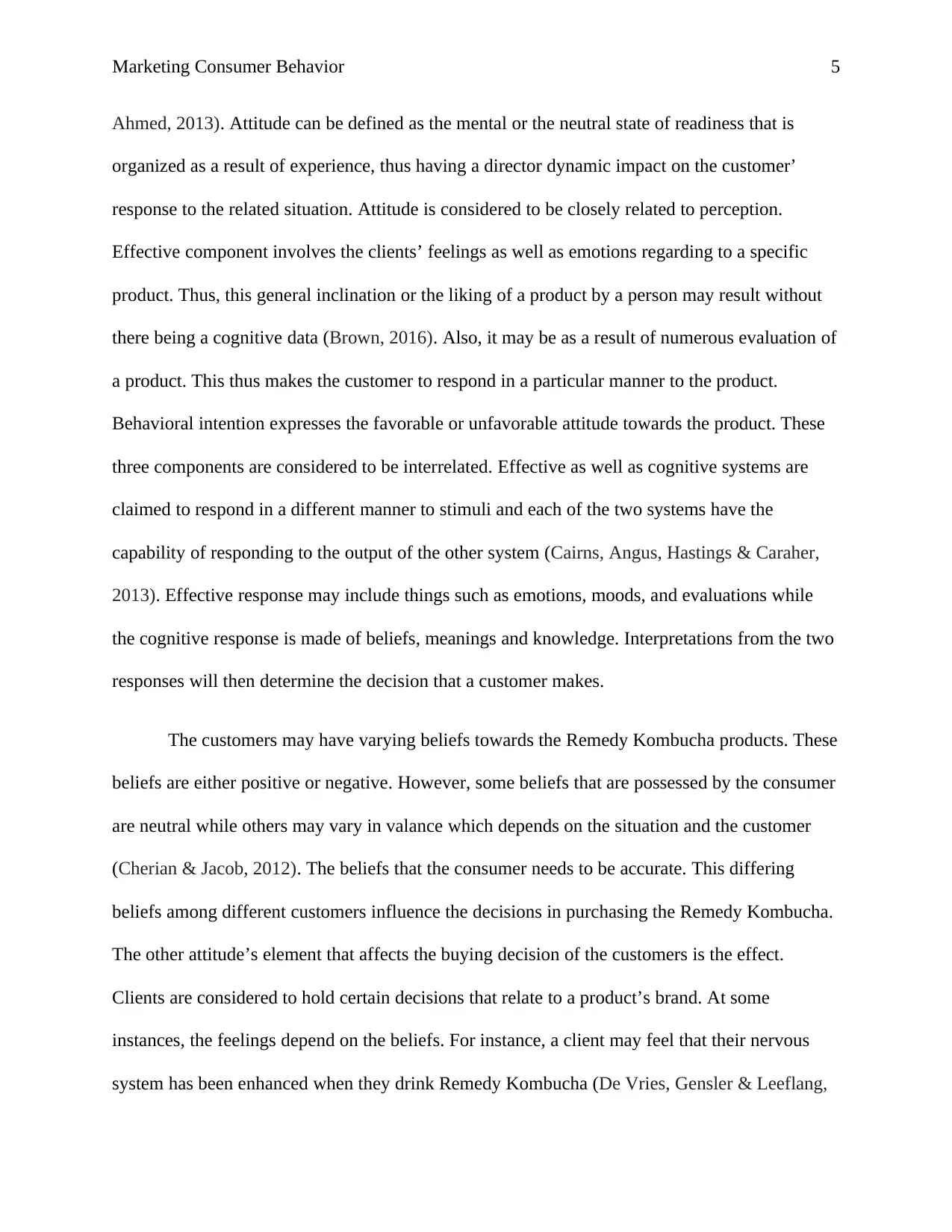
Marketing Consumer Behavior 5
Ahmed, 2013). Attitude can be defined as the mental or the neutral state of readiness that is
organized as a result of experience, thus having a director dynamic impact on the customer’
response to the related situation. Attitude is considered to be closely related to perception.
Effective component involves the clients’ feelings as well as emotions regarding to a specific
product. Thus, this general inclination or the liking of a product by a person may result without
there being a cognitive data (Brown, 2016). Also, it may be as a result of numerous evaluation of
a product. This thus makes the customer to respond in a particular manner to the product.
Behavioral intention expresses the favorable or unfavorable attitude towards the product. These
three components are considered to be interrelated. Effective as well as cognitive systems are
claimed to respond in a different manner to stimuli and each of the two systems have the
capability of responding to the output of the other system (Cairns, Angus, Hastings & Caraher,
2013). Effective response may include things such as emotions, moods, and evaluations while
the cognitive response is made of beliefs, meanings and knowledge. Interpretations from the two
responses will then determine the decision that a customer makes.
The customers may have varying beliefs towards the Remedy Kombucha products. These
beliefs are either positive or negative. However, some beliefs that are possessed by the consumer
are neutral while others may vary in valance which depends on the situation and the customer
(Cherian & Jacob, 2012). The beliefs that the consumer needs to be accurate. This differing
beliefs among different customers influence the decisions in purchasing the Remedy Kombucha.
The other attitude’s element that affects the buying decision of the customers is the effect.
Clients are considered to hold certain decisions that relate to a product’s brand. At some
instances, the feelings depend on the beliefs. For instance, a client may feel that their nervous
system has been enhanced when they drink Remedy Kombucha (De Vries, Gensler & Leeflang,
Ahmed, 2013). Attitude can be defined as the mental or the neutral state of readiness that is
organized as a result of experience, thus having a director dynamic impact on the customer’
response to the related situation. Attitude is considered to be closely related to perception.
Effective component involves the clients’ feelings as well as emotions regarding to a specific
product. Thus, this general inclination or the liking of a product by a person may result without
there being a cognitive data (Brown, 2016). Also, it may be as a result of numerous evaluation of
a product. This thus makes the customer to respond in a particular manner to the product.
Behavioral intention expresses the favorable or unfavorable attitude towards the product. These
three components are considered to be interrelated. Effective as well as cognitive systems are
claimed to respond in a different manner to stimuli and each of the two systems have the
capability of responding to the output of the other system (Cairns, Angus, Hastings & Caraher,
2013). Effective response may include things such as emotions, moods, and evaluations while
the cognitive response is made of beliefs, meanings and knowledge. Interpretations from the two
responses will then determine the decision that a customer makes.
The customers may have varying beliefs towards the Remedy Kombucha products. These
beliefs are either positive or negative. However, some beliefs that are possessed by the consumer
are neutral while others may vary in valance which depends on the situation and the customer
(Cherian & Jacob, 2012). The beliefs that the consumer needs to be accurate. This differing
beliefs among different customers influence the decisions in purchasing the Remedy Kombucha.
The other attitude’s element that affects the buying decision of the customers is the effect.
Clients are considered to hold certain decisions that relate to a product’s brand. At some
instances, the feelings depend on the beliefs. For instance, a client may feel that their nervous
system has been enhanced when they drink Remedy Kombucha (De Vries, Gensler & Leeflang,

Marketing Consumer Behavior 6
2012). However, other feelings are completely independent of beliefs. The manner in which a
consumer feels affected by the drink will thus define their buying decision. Nonetheless,
behavioral intention is another attitude’s element whereby the customer decide whether or not to
buy a product. Despite that the client does like the product, they would end up purchasing it
because their friends use the product hence affecting the consumer’s purchasing decision of
Remedy Products.
Consumer Buying Process
The customer’s buying process consists of five stages through which customers are
engaged in as they purchase goods and products. Nonetheless, in purchases that are considered to
be routinely, there is the possibility of customers skipping as well as reversing some of these
levels (Furaiji, Łatuszyńska & Wawrzyniak, 2012). For instance, study indicates that according
Nike’s company, a student buying a shoe would end up recognizing the need and as a result,
make the decision directly of purchasing the issue thus the student skips the other stages of
collecting information and evaluating. Another instance is when a client is loyal to a product and
thus end up skipping the other stages thus purchasing the same product that they had previously
bought (Gössling, Scott, Hall, Ceron & Dubois, 2012). In clarifying the customer’s buying
decision, it is observed that clients normally possess boundless demand in fulfilling their needs
as well as the fulfilment of having something new. A lot of literature review carried out to review
the client’s buying decision indicate that a lot of issues which determine whether a client is to
buy a product or not to buy. According to Sciffman and Kanuk (2004) there are basically four
opinions which are used to elaborate the consumer decision as well as their behavior such as the
economic view that outstands all the other views as having a greater impact on the customer’s
purchasing behavior that is reflected by the manner which clients make a choice on the products
2012). However, other feelings are completely independent of beliefs. The manner in which a
consumer feels affected by the drink will thus define their buying decision. Nonetheless,
behavioral intention is another attitude’s element whereby the customer decide whether or not to
buy a product. Despite that the client does like the product, they would end up purchasing it
because their friends use the product hence affecting the consumer’s purchasing decision of
Remedy Products.
Consumer Buying Process
The customer’s buying process consists of five stages through which customers are
engaged in as they purchase goods and products. Nonetheless, in purchases that are considered to
be routinely, there is the possibility of customers skipping as well as reversing some of these
levels (Furaiji, Łatuszyńska & Wawrzyniak, 2012). For instance, study indicates that according
Nike’s company, a student buying a shoe would end up recognizing the need and as a result,
make the decision directly of purchasing the issue thus the student skips the other stages of
collecting information and evaluating. Another instance is when a client is loyal to a product and
thus end up skipping the other stages thus purchasing the same product that they had previously
bought (Gössling, Scott, Hall, Ceron & Dubois, 2012). In clarifying the customer’s buying
decision, it is observed that clients normally possess boundless demand in fulfilling their needs
as well as the fulfilment of having something new. A lot of literature review carried out to review
the client’s buying decision indicate that a lot of issues which determine whether a client is to
buy a product or not to buy. According to Sciffman and Kanuk (2004) there are basically four
opinions which are used to elaborate the consumer decision as well as their behavior such as the
economic view that outstands all the other views as having a greater impact on the customer’s
purchasing behavior that is reflected by the manner which clients make a choice on the products
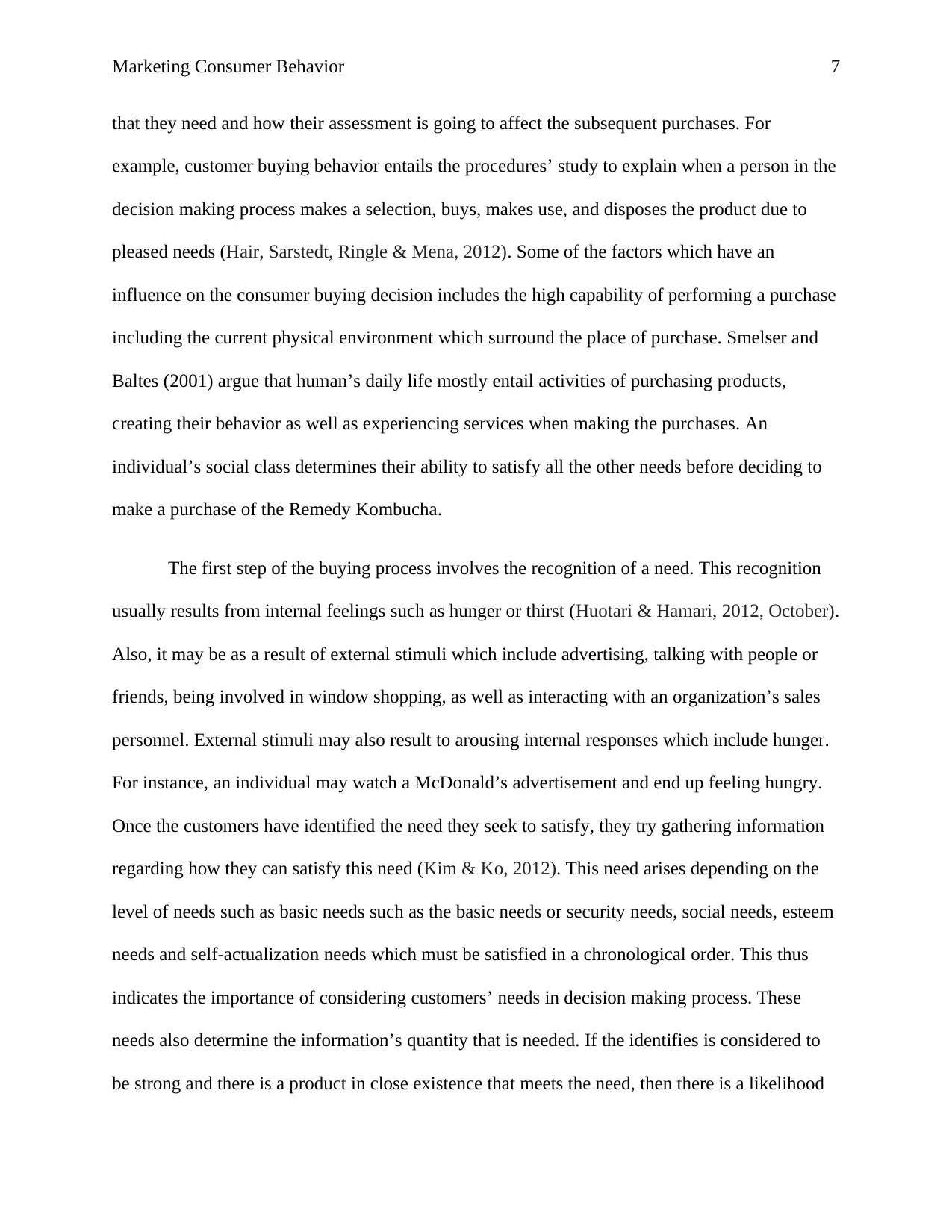
Marketing Consumer Behavior 7
that they need and how their assessment is going to affect the subsequent purchases. For
example, customer buying behavior entails the procedures’ study to explain when a person in the
decision making process makes a selection, buys, makes use, and disposes the product due to
pleased needs (Hair, Sarstedt, Ringle & Mena, 2012). Some of the factors which have an
influence on the consumer buying decision includes the high capability of performing a purchase
including the current physical environment which surround the place of purchase. Smelser and
Baltes (2001) argue that human’s daily life mostly entail activities of purchasing products,
creating their behavior as well as experiencing services when making the purchases. An
individual’s social class determines their ability to satisfy all the other needs before deciding to
make a purchase of the Remedy Kombucha.
The first step of the buying process involves the recognition of a need. This recognition
usually results from internal feelings such as hunger or thirst (Huotari & Hamari, 2012, October).
Also, it may be as a result of external stimuli which include advertising, talking with people or
friends, being involved in window shopping, as well as interacting with an organization’s sales
personnel. External stimuli may also result to arousing internal responses which include hunger.
For instance, an individual may watch a McDonald’s advertisement and end up feeling hungry.
Once the customers have identified the need they seek to satisfy, they try gathering information
regarding how they can satisfy this need (Kim & Ko, 2012). This need arises depending on the
level of needs such as basic needs such as the basic needs or security needs, social needs, esteem
needs and self-actualization needs which must be satisfied in a chronological order. This thus
indicates the importance of considering customers’ needs in decision making process. These
needs also determine the information’s quantity that is needed. If the identifies is considered to
be strong and there is a product in close existence that meets the need, then there is a likelihood
that they need and how their assessment is going to affect the subsequent purchases. For
example, customer buying behavior entails the procedures’ study to explain when a person in the
decision making process makes a selection, buys, makes use, and disposes the product due to
pleased needs (Hair, Sarstedt, Ringle & Mena, 2012). Some of the factors which have an
influence on the consumer buying decision includes the high capability of performing a purchase
including the current physical environment which surround the place of purchase. Smelser and
Baltes (2001) argue that human’s daily life mostly entail activities of purchasing products,
creating their behavior as well as experiencing services when making the purchases. An
individual’s social class determines their ability to satisfy all the other needs before deciding to
make a purchase of the Remedy Kombucha.
The first step of the buying process involves the recognition of a need. This recognition
usually results from internal feelings such as hunger or thirst (Huotari & Hamari, 2012, October).
Also, it may be as a result of external stimuli which include advertising, talking with people or
friends, being involved in window shopping, as well as interacting with an organization’s sales
personnel. External stimuli may also result to arousing internal responses which include hunger.
For instance, an individual may watch a McDonald’s advertisement and end up feeling hungry.
Once the customers have identified the need they seek to satisfy, they try gathering information
regarding how they can satisfy this need (Kim & Ko, 2012). This need arises depending on the
level of needs such as basic needs such as the basic needs or security needs, social needs, esteem
needs and self-actualization needs which must be satisfied in a chronological order. This thus
indicates the importance of considering customers’ needs in decision making process. These
needs also determine the information’s quantity that is needed. If the identifies is considered to
be strong and there is a product in close existence that meets the need, then there is a likelihood
Secure Best Marks with AI Grader
Need help grading? Try our AI Grader for instant feedback on your assignments.
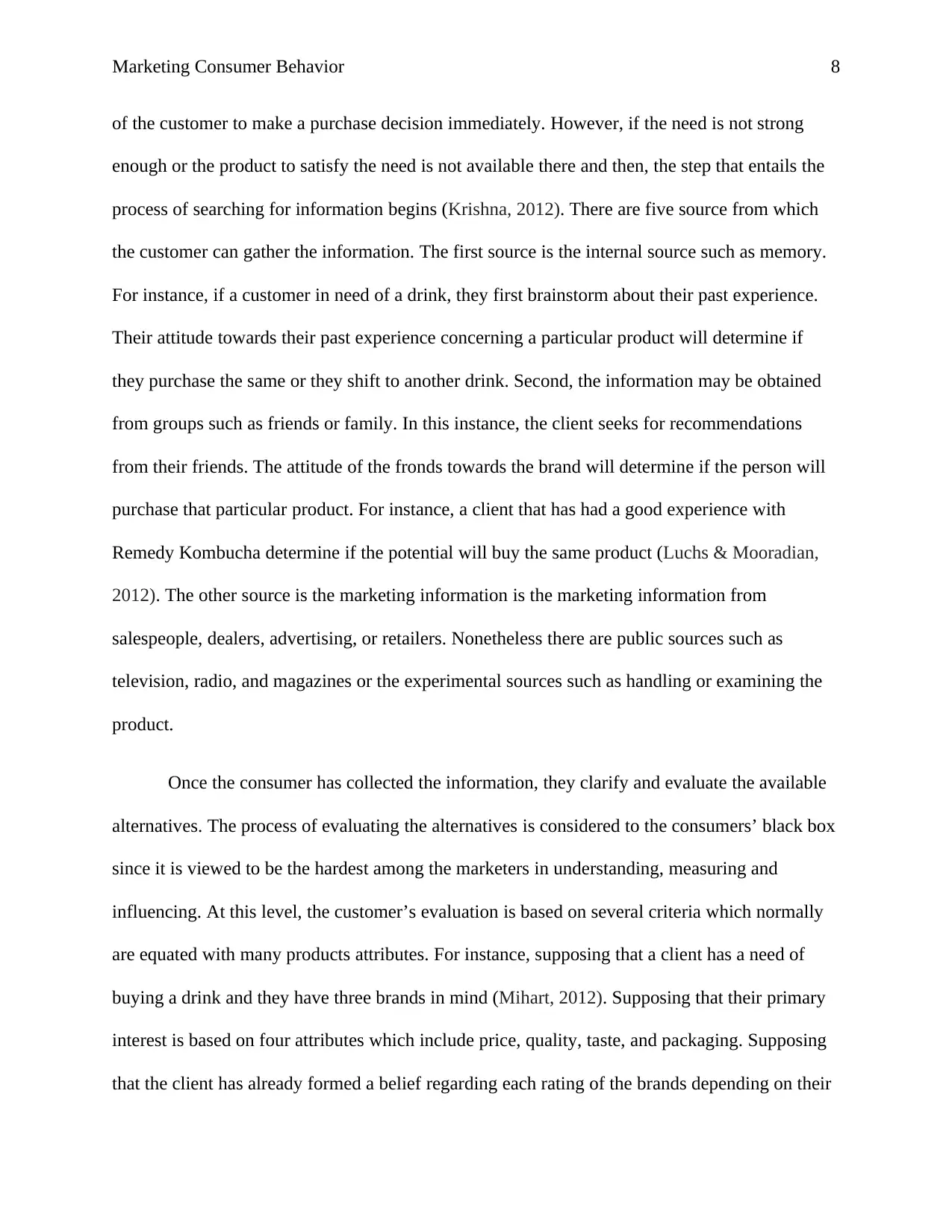
Marketing Consumer Behavior 8
of the customer to make a purchase decision immediately. However, if the need is not strong
enough or the product to satisfy the need is not available there and then, the step that entails the
process of searching for information begins (Krishna, 2012). There are five source from which
the customer can gather the information. The first source is the internal source such as memory.
For instance, if a customer in need of a drink, they first brainstorm about their past experience.
Their attitude towards their past experience concerning a particular product will determine if
they purchase the same or they shift to another drink. Second, the information may be obtained
from groups such as friends or family. In this instance, the client seeks for recommendations
from their friends. The attitude of the fronds towards the brand will determine if the person will
purchase that particular product. For instance, a client that has had a good experience with
Remedy Kombucha determine if the potential will buy the same product (Luchs & Mooradian,
2012). The other source is the marketing information is the marketing information from
salespeople, dealers, advertising, or retailers. Nonetheless there are public sources such as
television, radio, and magazines or the experimental sources such as handling or examining the
product.
Once the consumer has collected the information, they clarify and evaluate the available
alternatives. The process of evaluating the alternatives is considered to the consumers’ black box
since it is viewed to be the hardest among the marketers in understanding, measuring and
influencing. At this level, the customer’s evaluation is based on several criteria which normally
are equated with many products attributes. For instance, supposing that a client has a need of
buying a drink and they have three brands in mind (Mihart, 2012). Supposing that their primary
interest is based on four attributes which include price, quality, taste, and packaging. Supposing
that the client has already formed a belief regarding each rating of the brands depending on their
of the customer to make a purchase decision immediately. However, if the need is not strong
enough or the product to satisfy the need is not available there and then, the step that entails the
process of searching for information begins (Krishna, 2012). There are five source from which
the customer can gather the information. The first source is the internal source such as memory.
For instance, if a customer in need of a drink, they first brainstorm about their past experience.
Their attitude towards their past experience concerning a particular product will determine if
they purchase the same or they shift to another drink. Second, the information may be obtained
from groups such as friends or family. In this instance, the client seeks for recommendations
from their friends. The attitude of the fronds towards the brand will determine if the person will
purchase that particular product. For instance, a client that has had a good experience with
Remedy Kombucha determine if the potential will buy the same product (Luchs & Mooradian,
2012). The other source is the marketing information is the marketing information from
salespeople, dealers, advertising, or retailers. Nonetheless there are public sources such as
television, radio, and magazines or the experimental sources such as handling or examining the
product.
Once the consumer has collected the information, they clarify and evaluate the available
alternatives. The process of evaluating the alternatives is considered to the consumers’ black box
since it is viewed to be the hardest among the marketers in understanding, measuring and
influencing. At this level, the customer’s evaluation is based on several criteria which normally
are equated with many products attributes. For instance, supposing that a client has a need of
buying a drink and they have three brands in mind (Mihart, 2012). Supposing that their primary
interest is based on four attributes which include price, quality, taste, and packaging. Supposing
that the client has already formed a belief regarding each rating of the brands depending on their
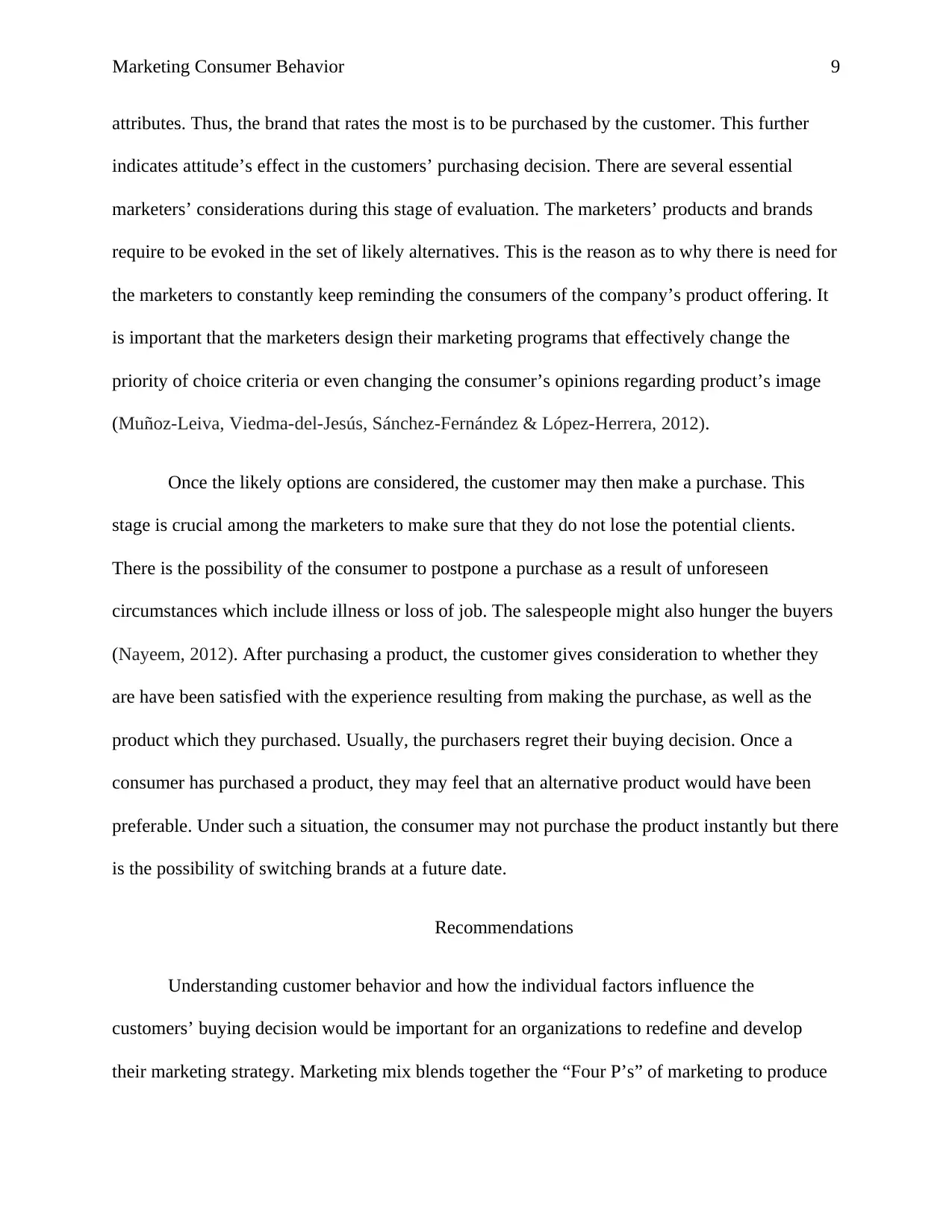
Marketing Consumer Behavior 9
attributes. Thus, the brand that rates the most is to be purchased by the customer. This further
indicates attitude’s effect in the customers’ purchasing decision. There are several essential
marketers’ considerations during this stage of evaluation. The marketers’ products and brands
require to be evoked in the set of likely alternatives. This is the reason as to why there is need for
the marketers to constantly keep reminding the consumers of the company’s product offering. It
is important that the marketers design their marketing programs that effectively change the
priority of choice criteria or even changing the consumer’s opinions regarding product’s image
(Muñoz-Leiva, Viedma-del-Jesús, Sánchez-Fernández & López-Herrera, 2012).
Once the likely options are considered, the customer may then make a purchase. This
stage is crucial among the marketers to make sure that they do not lose the potential clients.
There is the possibility of the consumer to postpone a purchase as a result of unforeseen
circumstances which include illness or loss of job. The salespeople might also hunger the buyers
(Nayeem, 2012). After purchasing a product, the customer gives consideration to whether they
are have been satisfied with the experience resulting from making the purchase, as well as the
product which they purchased. Usually, the purchasers regret their buying decision. Once a
consumer has purchased a product, they may feel that an alternative product would have been
preferable. Under such a situation, the consumer may not purchase the product instantly but there
is the possibility of switching brands at a future date.
Recommendations
Understanding customer behavior and how the individual factors influence the
customers’ buying decision would be important for an organizations to redefine and develop
their marketing strategy. Marketing mix blends together the “Four P’s” of marketing to produce
attributes. Thus, the brand that rates the most is to be purchased by the customer. This further
indicates attitude’s effect in the customers’ purchasing decision. There are several essential
marketers’ considerations during this stage of evaluation. The marketers’ products and brands
require to be evoked in the set of likely alternatives. This is the reason as to why there is need for
the marketers to constantly keep reminding the consumers of the company’s product offering. It
is important that the marketers design their marketing programs that effectively change the
priority of choice criteria or even changing the consumer’s opinions regarding product’s image
(Muñoz-Leiva, Viedma-del-Jesús, Sánchez-Fernández & López-Herrera, 2012).
Once the likely options are considered, the customer may then make a purchase. This
stage is crucial among the marketers to make sure that they do not lose the potential clients.
There is the possibility of the consumer to postpone a purchase as a result of unforeseen
circumstances which include illness or loss of job. The salespeople might also hunger the buyers
(Nayeem, 2012). After purchasing a product, the customer gives consideration to whether they
are have been satisfied with the experience resulting from making the purchase, as well as the
product which they purchased. Usually, the purchasers regret their buying decision. Once a
consumer has purchased a product, they may feel that an alternative product would have been
preferable. Under such a situation, the consumer may not purchase the product instantly but there
is the possibility of switching brands at a future date.
Recommendations
Understanding customer behavior and how the individual factors influence the
customers’ buying decision would be important for an organizations to redefine and develop
their marketing strategy. Marketing mix blends together the “Four P’s” of marketing to produce
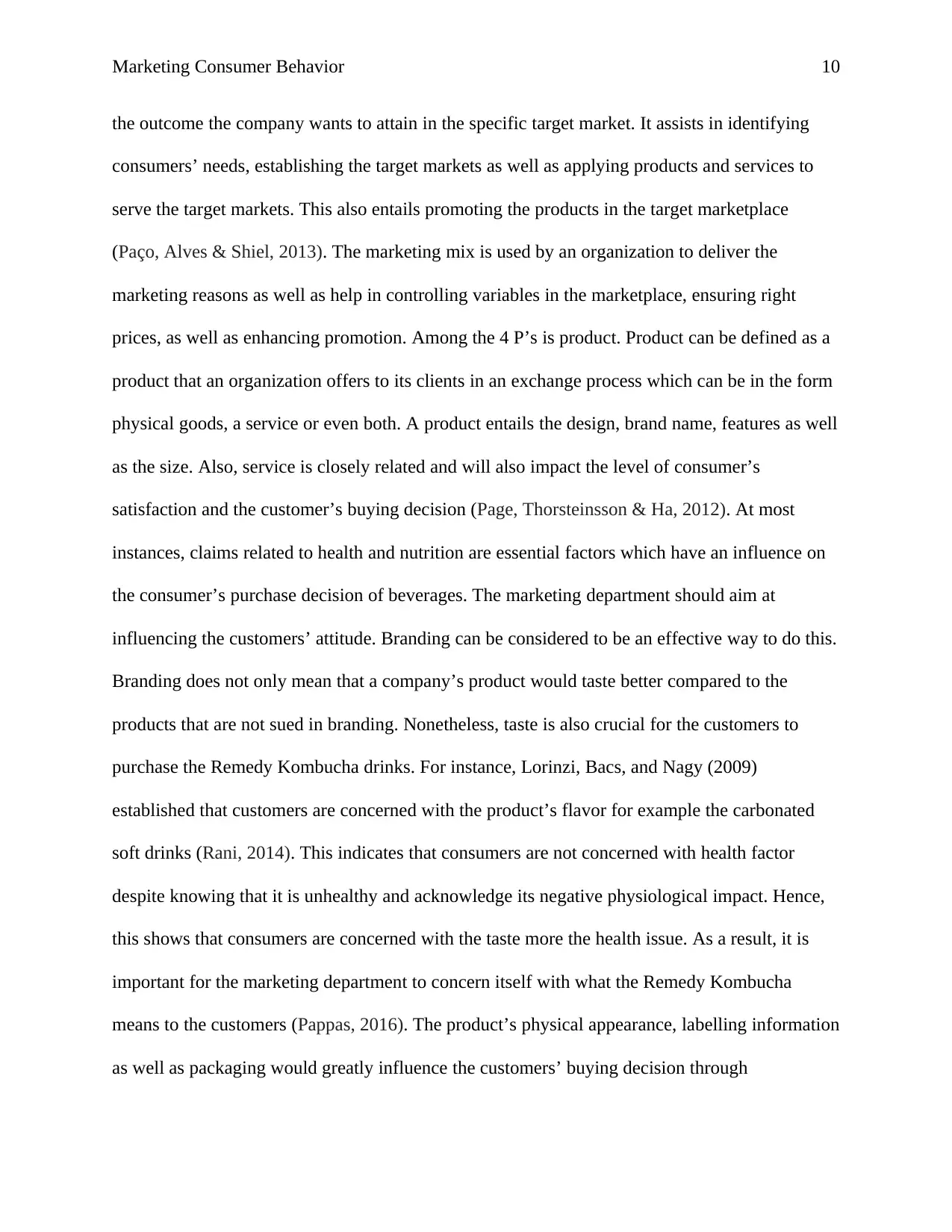
Marketing Consumer Behavior 10
the outcome the company wants to attain in the specific target market. It assists in identifying
consumers’ needs, establishing the target markets as well as applying products and services to
serve the target markets. This also entails promoting the products in the target marketplace
(Paço, Alves & Shiel, 2013). The marketing mix is used by an organization to deliver the
marketing reasons as well as help in controlling variables in the marketplace, ensuring right
prices, as well as enhancing promotion. Among the 4 P’s is product. Product can be defined as a
product that an organization offers to its clients in an exchange process which can be in the form
physical goods, a service or even both. A product entails the design, brand name, features as well
as the size. Also, service is closely related and will also impact the level of consumer’s
satisfaction and the customer’s buying decision (Page, Thorsteinsson & Ha, 2012). At most
instances, claims related to health and nutrition are essential factors which have an influence on
the consumer’s purchase decision of beverages. The marketing department should aim at
influencing the customers’ attitude. Branding can be considered to be an effective way to do this.
Branding does not only mean that a company’s product would taste better compared to the
products that are not sued in branding. Nonetheless, taste is also crucial for the customers to
purchase the Remedy Kombucha drinks. For instance, Lorinzi, Bacs, and Nagy (2009)
established that customers are concerned with the product’s flavor for example the carbonated
soft drinks (Rani, 2014). This indicates that consumers are not concerned with health factor
despite knowing that it is unhealthy and acknowledge its negative physiological impact. Hence,
this shows that consumers are concerned with the taste more the health issue. As a result, it is
important for the marketing department to concern itself with what the Remedy Kombucha
means to the customers (Pappas, 2016). The product’s physical appearance, labelling information
as well as packaging would greatly influence the customers’ buying decision through
the outcome the company wants to attain in the specific target market. It assists in identifying
consumers’ needs, establishing the target markets as well as applying products and services to
serve the target markets. This also entails promoting the products in the target marketplace
(Paço, Alves & Shiel, 2013). The marketing mix is used by an organization to deliver the
marketing reasons as well as help in controlling variables in the marketplace, ensuring right
prices, as well as enhancing promotion. Among the 4 P’s is product. Product can be defined as a
product that an organization offers to its clients in an exchange process which can be in the form
physical goods, a service or even both. A product entails the design, brand name, features as well
as the size. Also, service is closely related and will also impact the level of consumer’s
satisfaction and the customer’s buying decision (Page, Thorsteinsson & Ha, 2012). At most
instances, claims related to health and nutrition are essential factors which have an influence on
the consumer’s purchase decision of beverages. The marketing department should aim at
influencing the customers’ attitude. Branding can be considered to be an effective way to do this.
Branding does not only mean that a company’s product would taste better compared to the
products that are not sued in branding. Nonetheless, taste is also crucial for the customers to
purchase the Remedy Kombucha drinks. For instance, Lorinzi, Bacs, and Nagy (2009)
established that customers are concerned with the product’s flavor for example the carbonated
soft drinks (Rani, 2014). This indicates that consumers are not concerned with health factor
despite knowing that it is unhealthy and acknowledge its negative physiological impact. Hence,
this shows that consumers are concerned with the taste more the health issue. As a result, it is
important for the marketing department to concern itself with what the Remedy Kombucha
means to the customers (Pappas, 2016). The product’s physical appearance, labelling information
as well as packaging would greatly influence the customers’ buying decision through
Paraphrase This Document
Need a fresh take? Get an instant paraphrase of this document with our AI Paraphraser

Marketing Consumer Behavior 11
enhancement of their attitude. Nonetheless, Peter and Donally (2007) establishes that an
organization can further promote marketing by differentiating the company’s from competition
as well as enhance consumer perception the Remedy Kombucha is worth buying (Rödiger &
Hamm, 2015). Also, adding value to the product could enhance the consumer’s buying decision.
Customers are more inclined on the product’s nutrition and convenience thus making it an
opportunity for the organization to develop and enhance the Remedy Kombucha brands. There is
need for the organization to concern itself to the client’s needs regarding the quality, product’s
variety, and packaging which are more essential compared to price (Pérez, del Mar García de los
Salmones & Rodríguez, 2013). Goods that are value-added are considered to provide better
results and handling. Value addition can include the use of production methods such as grass-fed,
hormone free, and organic method that is used in the production of Remedy Kombucha. The
company should enhance its value-addition techniques to incorporate other methods.
Nonetheless, the product’s value-addition by the marketing department may end up failing if the
product fails to conform to consumer’s needs and satisfaction (Spurling, McMeekin, Southerton,
Shove & Welch, 2013). It is thus important that the organization ensures that the Remedy
Kombucha responds to the clients’ needs.
The second marketing mix that the company should use to redesign and develop its
marketing strategy is the promotion. The company’s marketing and advertising managers have
the responsibility of strategically placing the Remedy Kombucha prominently through the
promotion with the intention of guaranteeing the desired impact (Stelzner, 2014). The study
conducted by Pedraja and Yague (2011) indicate that the consumers make use of information
availed through advertising, and the information they obtain from the retail centers as their
external source of information. This information is used to assist in reducing perceived
enhancement of their attitude. Nonetheless, Peter and Donally (2007) establishes that an
organization can further promote marketing by differentiating the company’s from competition
as well as enhance consumer perception the Remedy Kombucha is worth buying (Rödiger &
Hamm, 2015). Also, adding value to the product could enhance the consumer’s buying decision.
Customers are more inclined on the product’s nutrition and convenience thus making it an
opportunity for the organization to develop and enhance the Remedy Kombucha brands. There is
need for the organization to concern itself to the client’s needs regarding the quality, product’s
variety, and packaging which are more essential compared to price (Pérez, del Mar García de los
Salmones & Rodríguez, 2013). Goods that are value-added are considered to provide better
results and handling. Value addition can include the use of production methods such as grass-fed,
hormone free, and organic method that is used in the production of Remedy Kombucha. The
company should enhance its value-addition techniques to incorporate other methods.
Nonetheless, the product’s value-addition by the marketing department may end up failing if the
product fails to conform to consumer’s needs and satisfaction (Spurling, McMeekin, Southerton,
Shove & Welch, 2013). It is thus important that the organization ensures that the Remedy
Kombucha responds to the clients’ needs.
The second marketing mix that the company should use to redesign and develop its
marketing strategy is the promotion. The company’s marketing and advertising managers have
the responsibility of strategically placing the Remedy Kombucha prominently through the
promotion with the intention of guaranteeing the desired impact (Stelzner, 2014). The study
conducted by Pedraja and Yague (2011) indicate that the consumers make use of information
availed through advertising, and the information they obtain from the retail centers as their
external source of information. This information is used to assist in reducing perceived
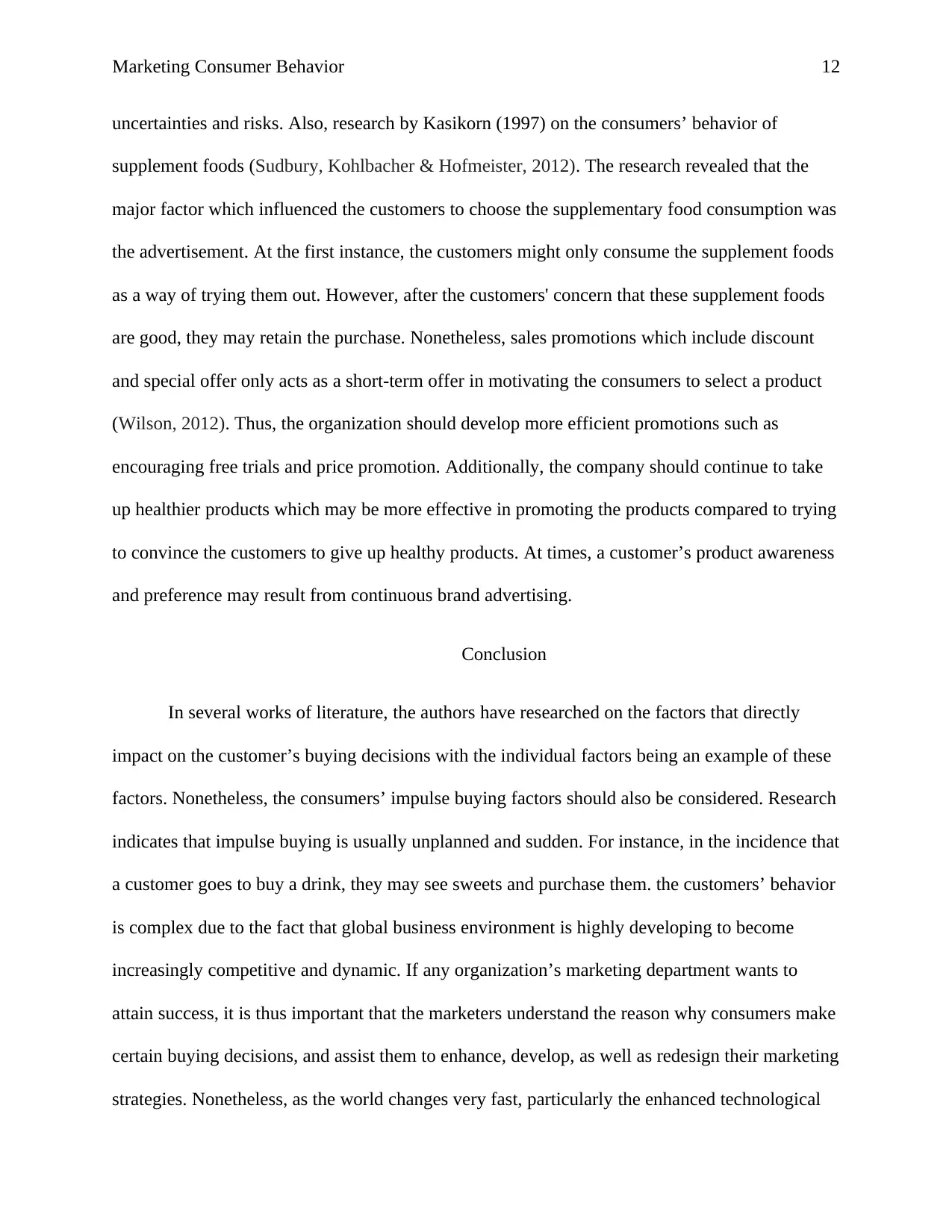
Marketing Consumer Behavior 12
uncertainties and risks. Also, research by Kasikorn (1997) on the consumers’ behavior of
supplement foods (Sudbury, Kohlbacher & Hofmeister, 2012). The research revealed that the
major factor which influenced the customers to choose the supplementary food consumption was
the advertisement. At the first instance, the customers might only consume the supplement foods
as a way of trying them out. However, after the customers' concern that these supplement foods
are good, they may retain the purchase. Nonetheless, sales promotions which include discount
and special offer only acts as a short-term offer in motivating the consumers to select a product
(Wilson, 2012). Thus, the organization should develop more efficient promotions such as
encouraging free trials and price promotion. Additionally, the company should continue to take
up healthier products which may be more effective in promoting the products compared to trying
to convince the customers to give up healthy products. At times, a customer’s product awareness
and preference may result from continuous brand advertising.
Conclusion
In several works of literature, the authors have researched on the factors that directly
impact on the customer’s buying decisions with the individual factors being an example of these
factors. Nonetheless, the consumers’ impulse buying factors should also be considered. Research
indicates that impulse buying is usually unplanned and sudden. For instance, in the incidence that
a customer goes to buy a drink, they may see sweets and purchase them. the customers’ behavior
is complex due to the fact that global business environment is highly developing to become
increasingly competitive and dynamic. If any organization’s marketing department wants to
attain success, it is thus important that the marketers understand the reason why consumers make
certain buying decisions, and assist them to enhance, develop, as well as redesign their marketing
strategies. Nonetheless, as the world changes very fast, particularly the enhanced technological
uncertainties and risks. Also, research by Kasikorn (1997) on the consumers’ behavior of
supplement foods (Sudbury, Kohlbacher & Hofmeister, 2012). The research revealed that the
major factor which influenced the customers to choose the supplementary food consumption was
the advertisement. At the first instance, the customers might only consume the supplement foods
as a way of trying them out. However, after the customers' concern that these supplement foods
are good, they may retain the purchase. Nonetheless, sales promotions which include discount
and special offer only acts as a short-term offer in motivating the consumers to select a product
(Wilson, 2012). Thus, the organization should develop more efficient promotions such as
encouraging free trials and price promotion. Additionally, the company should continue to take
up healthier products which may be more effective in promoting the products compared to trying
to convince the customers to give up healthy products. At times, a customer’s product awareness
and preference may result from continuous brand advertising.
Conclusion
In several works of literature, the authors have researched on the factors that directly
impact on the customer’s buying decisions with the individual factors being an example of these
factors. Nonetheless, the consumers’ impulse buying factors should also be considered. Research
indicates that impulse buying is usually unplanned and sudden. For instance, in the incidence that
a customer goes to buy a drink, they may see sweets and purchase them. the customers’ behavior
is complex due to the fact that global business environment is highly developing to become
increasingly competitive and dynamic. If any organization’s marketing department wants to
attain success, it is thus important that the marketers understand the reason why consumers make
certain buying decisions, and assist them to enhance, develop, as well as redesign their marketing
strategies. Nonetheless, as the world changes very fast, particularly the enhanced technological
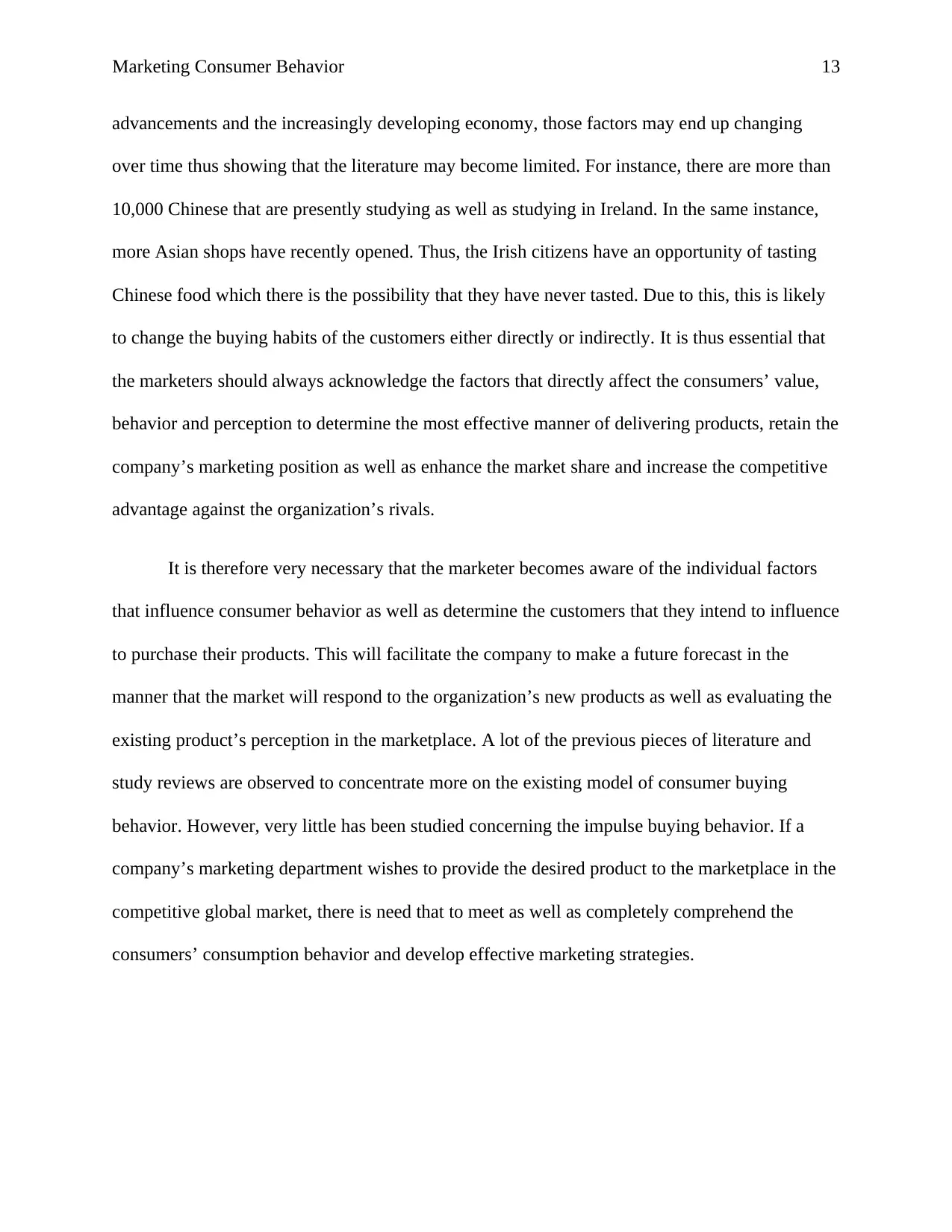
Marketing Consumer Behavior 13
advancements and the increasingly developing economy, those factors may end up changing
over time thus showing that the literature may become limited. For instance, there are more than
10,000 Chinese that are presently studying as well as studying in Ireland. In the same instance,
more Asian shops have recently opened. Thus, the Irish citizens have an opportunity of tasting
Chinese food which there is the possibility that they have never tasted. Due to this, this is likely
to change the buying habits of the customers either directly or indirectly. It is thus essential that
the marketers should always acknowledge the factors that directly affect the consumers’ value,
behavior and perception to determine the most effective manner of delivering products, retain the
company’s marketing position as well as enhance the market share and increase the competitive
advantage against the organization’s rivals.
It is therefore very necessary that the marketer becomes aware of the individual factors
that influence consumer behavior as well as determine the customers that they intend to influence
to purchase their products. This will facilitate the company to make a future forecast in the
manner that the market will respond to the organization’s new products as well as evaluating the
existing product’s perception in the marketplace. A lot of the previous pieces of literature and
study reviews are observed to concentrate more on the existing model of consumer buying
behavior. However, very little has been studied concerning the impulse buying behavior. If a
company’s marketing department wishes to provide the desired product to the marketplace in the
competitive global market, there is need that to meet as well as completely comprehend the
consumers’ consumption behavior and develop effective marketing strategies.
advancements and the increasingly developing economy, those factors may end up changing
over time thus showing that the literature may become limited. For instance, there are more than
10,000 Chinese that are presently studying as well as studying in Ireland. In the same instance,
more Asian shops have recently opened. Thus, the Irish citizens have an opportunity of tasting
Chinese food which there is the possibility that they have never tasted. Due to this, this is likely
to change the buying habits of the customers either directly or indirectly. It is thus essential that
the marketers should always acknowledge the factors that directly affect the consumers’ value,
behavior and perception to determine the most effective manner of delivering products, retain the
company’s marketing position as well as enhance the market share and increase the competitive
advantage against the organization’s rivals.
It is therefore very necessary that the marketer becomes aware of the individual factors
that influence consumer behavior as well as determine the customers that they intend to influence
to purchase their products. This will facilitate the company to make a future forecast in the
manner that the market will respond to the organization’s new products as well as evaluating the
existing product’s perception in the marketplace. A lot of the previous pieces of literature and
study reviews are observed to concentrate more on the existing model of consumer buying
behavior. However, very little has been studied concerning the impulse buying behavior. If a
company’s marketing department wishes to provide the desired product to the marketplace in the
competitive global market, there is need that to meet as well as completely comprehend the
consumers’ consumption behavior and develop effective marketing strategies.
Secure Best Marks with AI Grader
Need help grading? Try our AI Grader for instant feedback on your assignments.
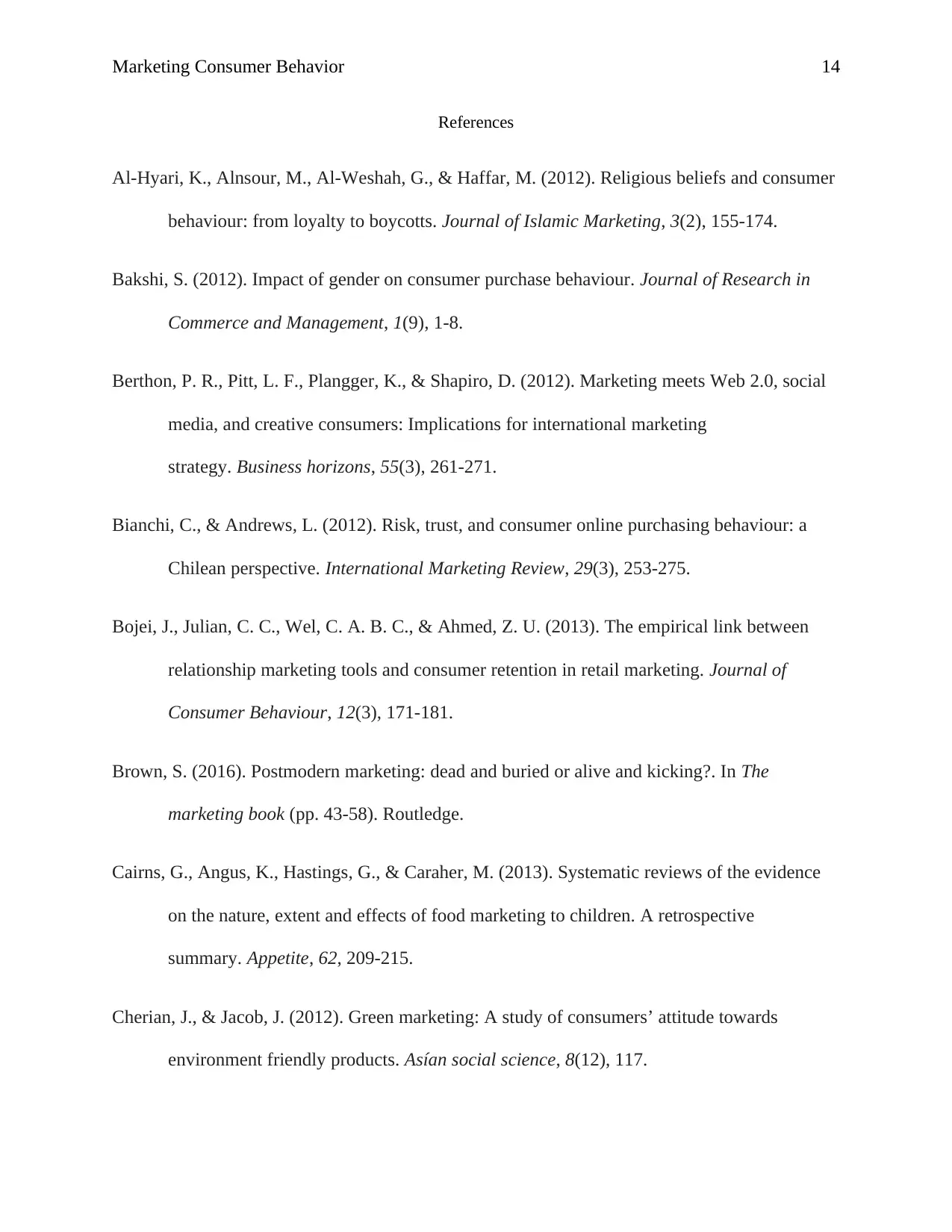
Marketing Consumer Behavior 14
References
Al-Hyari, K., Alnsour, M., Al-Weshah, G., & Haffar, M. (2012). Religious beliefs and consumer
behaviour: from loyalty to boycotts. Journal of Islamic Marketing, 3(2), 155-174.
Bakshi, S. (2012). Impact of gender on consumer purchase behaviour. Journal of Research in
Commerce and Management, 1(9), 1-8.
Berthon, P. R., Pitt, L. F., Plangger, K., & Shapiro, D. (2012). Marketing meets Web 2.0, social
media, and creative consumers: Implications for international marketing
strategy. Business horizons, 55(3), 261-271.
Bianchi, C., & Andrews, L. (2012). Risk, trust, and consumer online purchasing behaviour: a
Chilean perspective. International Marketing Review, 29(3), 253-275.
Bojei, J., Julian, C. C., Wel, C. A. B. C., & Ahmed, Z. U. (2013). The empirical link between
relationship marketing tools and consumer retention in retail marketing. Journal of
Consumer Behaviour, 12(3), 171-181.
Brown, S. (2016). Postmodern marketing: dead and buried or alive and kicking?. In The
marketing book (pp. 43-58). Routledge.
Cairns, G., Angus, K., Hastings, G., & Caraher, M. (2013). Systematic reviews of the evidence
on the nature, extent and effects of food marketing to children. A retrospective
summary. Appetite, 62, 209-215.
Cherian, J., & Jacob, J. (2012). Green marketing: A study of consumers’ attitude towards
environment friendly products. Asían social science, 8(12), 117.
References
Al-Hyari, K., Alnsour, M., Al-Weshah, G., & Haffar, M. (2012). Religious beliefs and consumer
behaviour: from loyalty to boycotts. Journal of Islamic Marketing, 3(2), 155-174.
Bakshi, S. (2012). Impact of gender on consumer purchase behaviour. Journal of Research in
Commerce and Management, 1(9), 1-8.
Berthon, P. R., Pitt, L. F., Plangger, K., & Shapiro, D. (2012). Marketing meets Web 2.0, social
media, and creative consumers: Implications for international marketing
strategy. Business horizons, 55(3), 261-271.
Bianchi, C., & Andrews, L. (2012). Risk, trust, and consumer online purchasing behaviour: a
Chilean perspective. International Marketing Review, 29(3), 253-275.
Bojei, J., Julian, C. C., Wel, C. A. B. C., & Ahmed, Z. U. (2013). The empirical link between
relationship marketing tools and consumer retention in retail marketing. Journal of
Consumer Behaviour, 12(3), 171-181.
Brown, S. (2016). Postmodern marketing: dead and buried or alive and kicking?. In The
marketing book (pp. 43-58). Routledge.
Cairns, G., Angus, K., Hastings, G., & Caraher, M. (2013). Systematic reviews of the evidence
on the nature, extent and effects of food marketing to children. A retrospective
summary. Appetite, 62, 209-215.
Cherian, J., & Jacob, J. (2012). Green marketing: A study of consumers’ attitude towards
environment friendly products. Asían social science, 8(12), 117.

Marketing Consumer Behavior 15
De Vries, L., Gensler, S., & Leeflang, P. S. (2012). Popularity of brand posts on brand fan pages:
An investigation of the effects of social media marketing. Journal of interactive
marketing, 26(2), 83-91.
Fall Diallo, M., Chandon, J. L., Cliquet, G., & Philippe, J. (2013). Factors influencing consumer
behaviour towards store brands: evidence from the French market. International Journal
of Retail & Distribution Management, 41(6), 422-441.
Furaiji, F., Łatuszyńska, M., & Wawrzyniak, A. (2012). An empirical study of the factors
influencing consumer behaviour in the electric appliances market.
Gössling, S., Scott, D., Hall, C. M., Ceron, J. P., & Dubois, G. (2012). Consumer behaviour and
demand response of tourists to climate change. Annals of Tourism Research, 39(1), 36-
58.
Hair, J. F., Sarstedt, M., Ringle, C. M., & Mena, J. A. (2012). An assessment of the use of partial
least squares structural equation modeling in marketing research. Journal of the academy
of marketing science, 40(3), 414-433.
Huotari, K., & Hamari, J. (2012, October). Defining gamification: a service marketing
perspective. In Proceeding of the 16th international academic MindTrek conference (pp.
17-22). ACM.
Kim, A. J., & Ko, E. (2012). Do social media marketing activities enhance customer equity? An
empirical study of luxury fashion brand. Journal of Business Research, 65(10), 1480-
1486.
De Vries, L., Gensler, S., & Leeflang, P. S. (2012). Popularity of brand posts on brand fan pages:
An investigation of the effects of social media marketing. Journal of interactive
marketing, 26(2), 83-91.
Fall Diallo, M., Chandon, J. L., Cliquet, G., & Philippe, J. (2013). Factors influencing consumer
behaviour towards store brands: evidence from the French market. International Journal
of Retail & Distribution Management, 41(6), 422-441.
Furaiji, F., Łatuszyńska, M., & Wawrzyniak, A. (2012). An empirical study of the factors
influencing consumer behaviour in the electric appliances market.
Gössling, S., Scott, D., Hall, C. M., Ceron, J. P., & Dubois, G. (2012). Consumer behaviour and
demand response of tourists to climate change. Annals of Tourism Research, 39(1), 36-
58.
Hair, J. F., Sarstedt, M., Ringle, C. M., & Mena, J. A. (2012). An assessment of the use of partial
least squares structural equation modeling in marketing research. Journal of the academy
of marketing science, 40(3), 414-433.
Huotari, K., & Hamari, J. (2012, October). Defining gamification: a service marketing
perspective. In Proceeding of the 16th international academic MindTrek conference (pp.
17-22). ACM.
Kim, A. J., & Ko, E. (2012). Do social media marketing activities enhance customer equity? An
empirical study of luxury fashion brand. Journal of Business Research, 65(10), 1480-
1486.
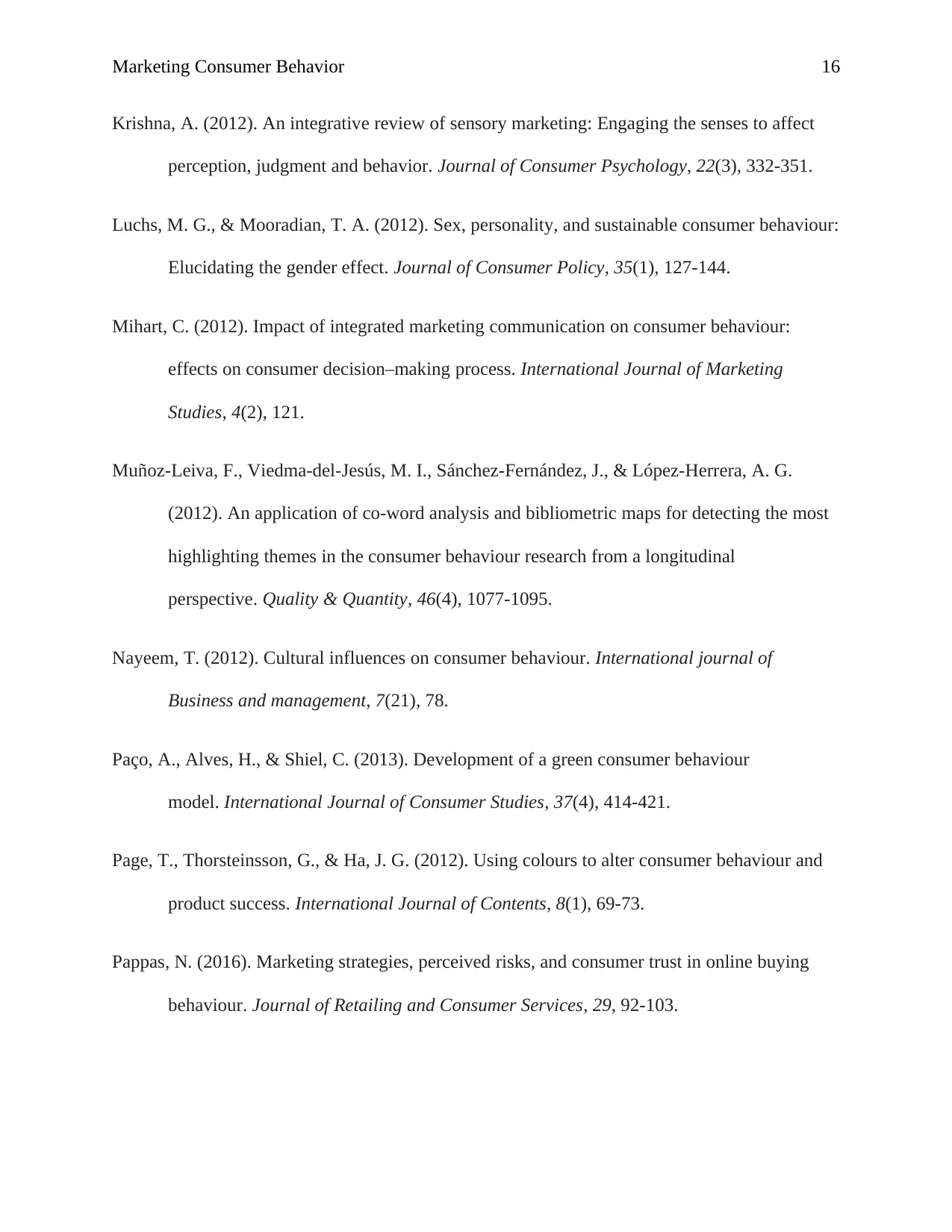
Marketing Consumer Behavior 16
Krishna, A. (2012). An integrative review of sensory marketing: Engaging the senses to affect
perception, judgment and behavior. Journal of Consumer Psychology, 22(3), 332-351.
Luchs, M. G., & Mooradian, T. A. (2012). Sex, personality, and sustainable consumer behaviour:
Elucidating the gender effect. Journal of Consumer Policy, 35(1), 127-144.
Mihart, C. (2012). Impact of integrated marketing communication on consumer behaviour:
effects on consumer decision–making process. International Journal of Marketing
Studies, 4(2), 121.
Muñoz-Leiva, F., Viedma-del-Jesús, M. I., Sánchez-Fernández, J., & López-Herrera, A. G.
(2012). An application of co-word analysis and bibliometric maps for detecting the most
highlighting themes in the consumer behaviour research from a longitudinal
perspective. Quality & Quantity, 46(4), 1077-1095.
Nayeem, T. (2012). Cultural influences on consumer behaviour. International journal of
Business and management, 7(21), 78.
Paço, A., Alves, H., & Shiel, C. (2013). Development of a green consumer behaviour
model. International Journal of Consumer Studies, 37(4), 414-421.
Page, T., Thorsteinsson, G., & Ha, J. G. (2012). Using colours to alter consumer behaviour and
product success. International Journal of Contents, 8(1), 69-73.
Pappas, N. (2016). Marketing strategies, perceived risks, and consumer trust in online buying
behaviour. Journal of Retailing and Consumer Services, 29, 92-103.
Krishna, A. (2012). An integrative review of sensory marketing: Engaging the senses to affect
perception, judgment and behavior. Journal of Consumer Psychology, 22(3), 332-351.
Luchs, M. G., & Mooradian, T. A. (2012). Sex, personality, and sustainable consumer behaviour:
Elucidating the gender effect. Journal of Consumer Policy, 35(1), 127-144.
Mihart, C. (2012). Impact of integrated marketing communication on consumer behaviour:
effects on consumer decision–making process. International Journal of Marketing
Studies, 4(2), 121.
Muñoz-Leiva, F., Viedma-del-Jesús, M. I., Sánchez-Fernández, J., & López-Herrera, A. G.
(2012). An application of co-word analysis and bibliometric maps for detecting the most
highlighting themes in the consumer behaviour research from a longitudinal
perspective. Quality & Quantity, 46(4), 1077-1095.
Nayeem, T. (2012). Cultural influences on consumer behaviour. International journal of
Business and management, 7(21), 78.
Paço, A., Alves, H., & Shiel, C. (2013). Development of a green consumer behaviour
model. International Journal of Consumer Studies, 37(4), 414-421.
Page, T., Thorsteinsson, G., & Ha, J. G. (2012). Using colours to alter consumer behaviour and
product success. International Journal of Contents, 8(1), 69-73.
Pappas, N. (2016). Marketing strategies, perceived risks, and consumer trust in online buying
behaviour. Journal of Retailing and Consumer Services, 29, 92-103.
Paraphrase This Document
Need a fresh take? Get an instant paraphrase of this document with our AI Paraphraser
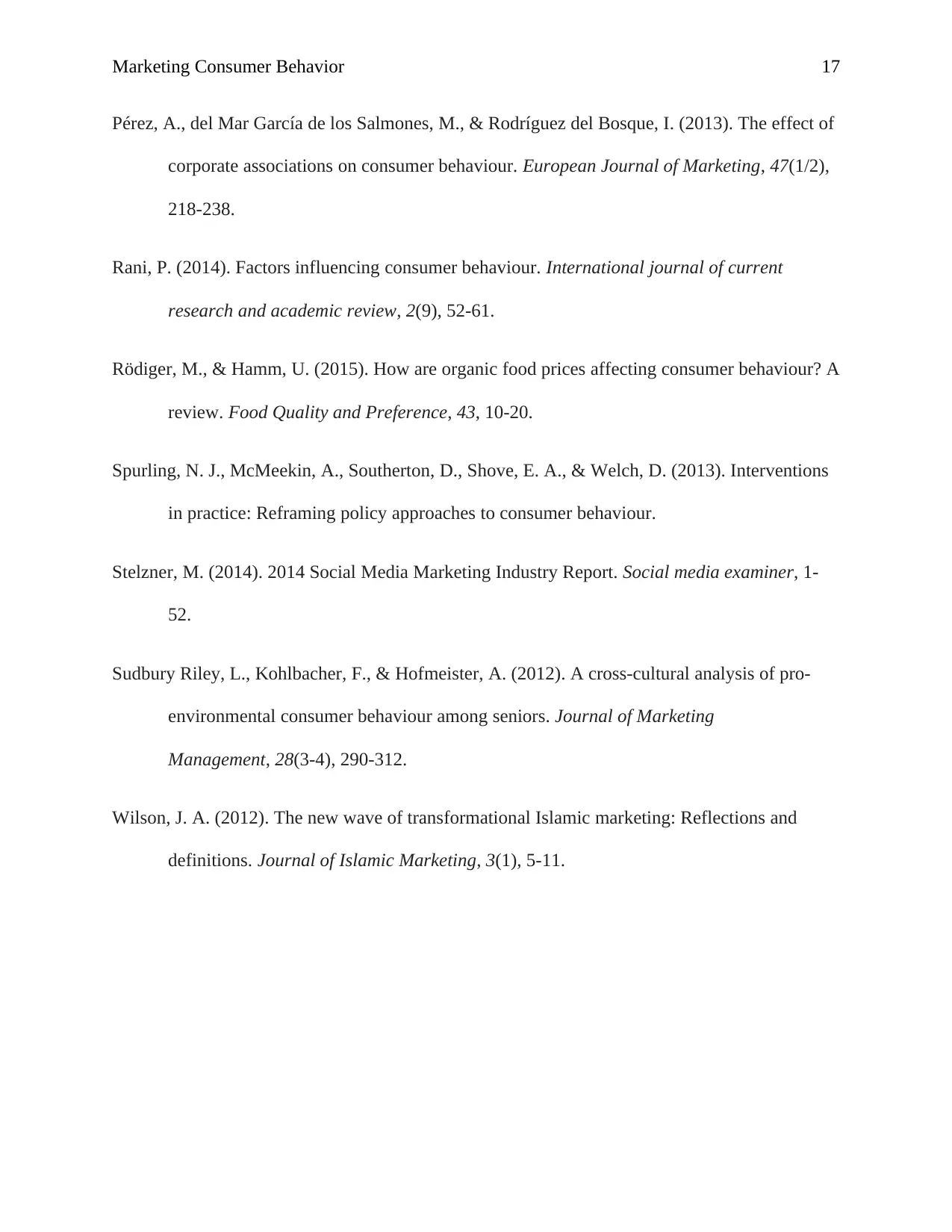
Marketing Consumer Behavior 17
Pérez, A., del Mar García de los Salmones, M., & Rodríguez del Bosque, I. (2013). The effect of
corporate associations on consumer behaviour. European Journal of Marketing, 47(1/2),
218-238.
Rani, P. (2014). Factors influencing consumer behaviour. International journal of current
research and academic review, 2(9), 52-61.
Rödiger, M., & Hamm, U. (2015). How are organic food prices affecting consumer behaviour? A
review. Food Quality and Preference, 43, 10-20.
Spurling, N. J., McMeekin, A., Southerton, D., Shove, E. A., & Welch, D. (2013). Interventions
in practice: Reframing policy approaches to consumer behaviour.
Stelzner, M. (2014). 2014 Social Media Marketing Industry Report. Social media examiner, 1-
52.
Sudbury Riley, L., Kohlbacher, F., & Hofmeister, A. (2012). A cross-cultural analysis of pro-
environmental consumer behaviour among seniors. Journal of Marketing
Management, 28(3-4), 290-312.
Wilson, J. A. (2012). The new wave of transformational Islamic marketing: Reflections and
definitions. Journal of Islamic Marketing, 3(1), 5-11.
Pérez, A., del Mar García de los Salmones, M., & Rodríguez del Bosque, I. (2013). The effect of
corporate associations on consumer behaviour. European Journal of Marketing, 47(1/2),
218-238.
Rani, P. (2014). Factors influencing consumer behaviour. International journal of current
research and academic review, 2(9), 52-61.
Rödiger, M., & Hamm, U. (2015). How are organic food prices affecting consumer behaviour? A
review. Food Quality and Preference, 43, 10-20.
Spurling, N. J., McMeekin, A., Southerton, D., Shove, E. A., & Welch, D. (2013). Interventions
in practice: Reframing policy approaches to consumer behaviour.
Stelzner, M. (2014). 2014 Social Media Marketing Industry Report. Social media examiner, 1-
52.
Sudbury Riley, L., Kohlbacher, F., & Hofmeister, A. (2012). A cross-cultural analysis of pro-
environmental consumer behaviour among seniors. Journal of Marketing
Management, 28(3-4), 290-312.
Wilson, J. A. (2012). The new wave of transformational Islamic marketing: Reflections and
definitions. Journal of Islamic Marketing, 3(1), 5-11.
1 out of 17
![[object Object]](/_next/static/media/star-bottom.7253800d.svg)





